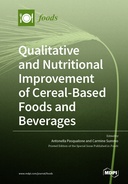Explore

Qualitative and Nutritional Improvement of Cereal-Based Foods and Beverages
0 Ungluers have
Faved this Work
Login to Fave
Increased consumer awareness of the effects of food in preventing nutrient-related diseases and maintaining physical and mental well-being has made nutritional improvement an important goal for the food and beverage industry, including the cereal sector. The Book “Qualitative and Nutritional Improvement of Cereal-Based Foods and Beverages” collects research articles aimed at exploring innovative ways to improve cereal-based foods and beverages; an old—if not ancient—group of products which are still on our table every day. The main directions of research aimed at nutritional improvement have to face either excess or deficiency in the diet. To this end, different strategies may be adopted, such as the reformulation of products, the introduction of functional ingredients, and the application of biotechnologies to increase the bioavailability of bioactive compounds. These interventions, however, can alter the physico-chemical and sensory properties of final products, making it necessary to achieve a balance between nutritional and quality modification. This book offers readers information on innovative ways to improve cereal-based foods and beverages, useful for researchers and for industry operators.
This book is included in DOAB.
Why read this book? Have your say.
You must be logged in to comment.
Rights Information
Are you the author or publisher of this work? If so, you can claim it as yours by registering as an Unglue.it rights holder.Downloads
This work has been downloaded 124 times via unglue.it ebook links.
- 124 - pdf (CC BY) at Unglue.it.
Keywords
- almond skins
- alpha-amylase inhibition
- amaranth
- amino acids
- Anthocyanins
- anti-inflammatory activity
- antioxidant capacity
- antioxidant properties
- bakery products
- bioactive compounds
- biscuits
- Bread
- by-product
- byproducts
- cereal
- cereal beverage
- cereal-based ready-to-drink beverage
- chemical characterization
- chickpea
- Child
- coffee silverskin
- consumer acceptability
- convenient meal replacement (CMR)
- Dietary fiber
- djulis
- dough rheology
- extreme vertices mixture design
- extruded products
- extrusion
- extrusion-cooking
- Fermentation
- fiber
- flaxseed
- focaccia
- food aid
- food quality
- Fortification
- fortified blended foods (FBFs)
- fortified pasta
- functional
- Functional foods
- gamma-amino butyric acid (GABA)
- germinated wheat
- Health Benefits
- health claims
- Hemp
- Infant
- insect
- Insects
- inulin
- Lactic acid bacteria
- leavening agent
- legume
- low-sodium sea salt
- milling by-products
- Moringa oleifera
- Moringa oleifera leaf powder (MOLP)
- Na+ reduction
- NaCl
- new quality
- non-alcoholic
- nutritional composition
- nutritional value
- optimization
- pasta
- phenolic bioaccessibility
- phenolic compounds
- physico-chemical and textural attributes
- phytic acid
- pigmented wheat
- Pizza
- Polyphenols
- porridge
- product development
- protein energy malnutrition
- pulses
- re-milled semolina
- Reference, information & interdisciplinary subjects
- reofermentograph
- Research & information: general
- resistant starch
- response surface methodology (RSM)
- rheological properties
- roller milling
- sensory
- sensory attributes
- sensory evaluation
- sensory profile
- sensory properties
- slowly digestible starch
- sorghum
- sourdough
- starch digestion
- stone milling
- Taguchi grey relational analysis
- Texture
- texture profile analysis
- toxicological analysis
- Triticum turgidum L. subsp. durum Desf.
- upcycling
- wheat
- wholewheat flour
- xanthan gum
Links
DOI: 10.3390/books978-3-0365-0707-1Editions

